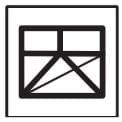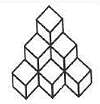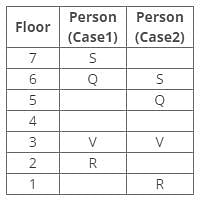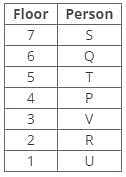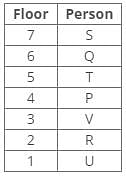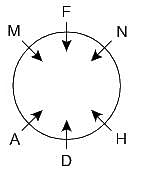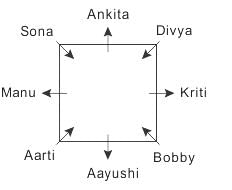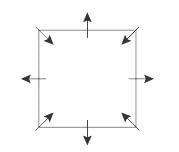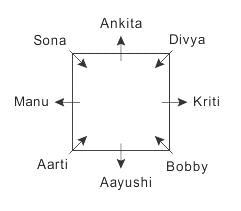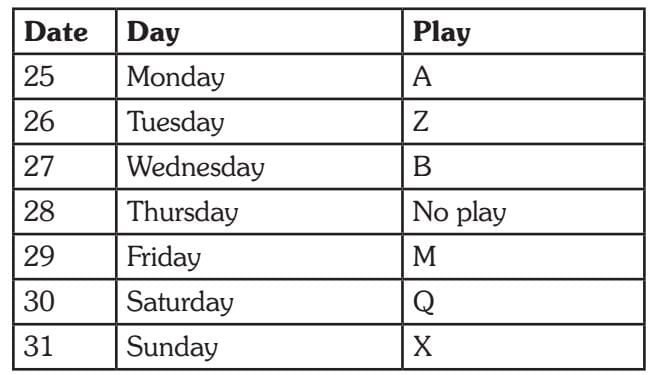JK Police Constable Mock Test - 6 - JK Police Constable MCQ
30 Questions MCQ Test JK Police Constable Mock Test Series 2024 - JK Police Constable Mock Test - 6
Directions: Study the following instructions carefully and then answer the questions that follow.
In making decisions about important questions it is desirable that a candidate is able to distinguish between 'strong' and 'weak' arguments so far as they relate to the questions.
'Weak' arguments may not be directly related to the questions and may be of minor importance or may be related to the trivial aspect of the question.
Each question below is followed by two arguments I and II. You have to decide which of the arguments is a 'strong' argument and which is a 'weak' argument.
Statement: Should there be compulsory medical examination of both the man and the woman before they marry each other?
Arguments:
(I) No. This is an intrusion to the privacy of an individual and hence cannot be tolerated.
(II) Yes. This will substantially reduce the risk of giving birth to children with serious ailment.
Direction: In each question below is given a statement followed by two assumption numbered I and II. An assumption is something supposed or taken for granted. You have to consider the statement and the following assumption and decide which of the assumption is implicit in the statement.
Statement:
Our urban young are less at ease with their own language than with English !
Assumptions:
I. One feels most comfortable with one's mothertongue.
II. English language books sell more than their vernacular counterparts.
Our urban young are less at ease with their own language than with English !
Assumptions:
I. One feels most comfortable with one's mothertongue.
II. English language books sell more than their vernacular counterparts.
| 1 Crore+ students have signed up on EduRev. Have you? Download the App |
Directions : In each of the following questions a statement is given, followed by two conclusions. Give answer :
Statement : Books without knowledge of life are useless..
Conclusion :
I. All books contain knowledge of life.
II. People should try to gain the knowledge of life.
I. All books contain knowledge of life.
II. People should try to gain the knowledge of life.
Direction: Study the following information and answer the given questions carefully.
Anurag is standing at point P, facing the north direction. He starts walking towards the west and reaches point Q after walking 12m. Then he moves 12m to his right towards point R. From point R, he again moves his right to reach point S, which is 8m apart from point R. He again moves towards the right to reach point T after covering a distance of 6m from point S. Finally, he moves 12m to his left to reach point U.
Q. Point U is in _____ direction of point S.
Direction: If a Paper (Transparent Sheet) is folded in a manner and a design or pattern is drawn. When unfolded this paper appears as given below in the answer figure. Choose the correct answer figure given below.
If the following pattern is drawn in a transparent square sheet and folded along the dotted lines, how does it appear?
Question Figure

Answer figure

Which of the following Figure best represents the relationship amongst the Human being, Girl, Boy?
Select the answer figure in which the question figure is hidden ?

In this questions, a number series is given with one term missing. Choose the correct alternative that will continue the same pattern and fill in the black spaces.
Q. 19, 2, 38, 3, 114, 4, (____)
Sudha wants to go to the university and starts from her home which is in the East and comes to a crossing. The road to her left ends in a theatre. Straight ahead lies the hospital. In which direction is the university?
Directions: From the given alternatives, find the word which cannot be formed from the letters used in the given word.
INFRASTRUCTURE
Which letter is exactly midway between H and S in the alphabet series?
In the following question, five figures are given. Out of them, find the three figures that can be joined to form an equilateral triangle.

Which answer figure will complete the pattern in the question figure?

Directions: Which of the following will replace the question mark (?) in the figures given below?

Direction: Read the following information carefully and answer the questions that follow.
Sunita is taller than Seeema and Renu, Renu is shorter than Radha and Gauri. Bina is taller than Radha and shorter than Sunita. Sunita is not the tallest and Renu is not the shortest.
Q. Who is the tallest?
Direction: Study the following information and answer the given questions carefully.
P, Q, R, S, T, U and V live on different floors of a building, in which floors are numbered 1 to 7 from bottom to top.
T lives above V. U does not live on an even-numbered floor. P lives below T but above V. Q lives immediately below S. V lives on the third floor. Exactly three persons live between Q and R who lives below Q.
Q. Who lives just below P?
Directions: A number arrangement machine when given an input line of numbers rearranges them following a particular rule in each step. The following is an illustration of input and rearrangement.
Input: 378557 467899 632978 984768 549489 755623
Step I: 10785 13678 14329 17847 14494 10556
Step II: 17825 46764 53281 88449 54916 15536
Step III: 17852 46764 35281 88494 45961 15563
Step IV: 6854 2768 2282 0498 1962 4566
/\ /\ /\ /\ /\ /\
Step V: 196 20 81 48 16 16 16 72 100 12 81 36
Find the different steps of output using the above-mentioned logic for the following input.
Input: 478667 578688 543867 765879 658574 866734
Q. In how many steps is an even number is immediately preceded and succeeded by an odd number?
Directions: Each of the following consists of a question and two statements numbered I and II given below it. You have to decide whether the data provided in the statements are sufficient to answer the question.
Six persons are sitting around a circular table and facing the centre. Who sits to the immediate left of N?
Statement I: H sits to the immediate right of D. Two persons sit between D and F. A is an immediate neighbour of M, who sits to the immediate right of F.
Statement II: F and N are immediate neighbours and M sits immediate right of F. A sits third to the left of N.
Direction: Study the following information carefully and answer the given questions besides.
Eight students Kirti, Ayushi, Manu, Sona, Aarti, Bobby, Ankita and Divya are sitting around the square table. Four students sit on each side while rest on each corner. Students at the side faces away from the centre and students at the corner faces toward the centre.
Divya sits third to the left of Ayushi. Sona sits immediate left of Ankita, who sits on the side of the table. Kirti sits opposite to Manu and both faces away from the centre. Neither Kirti nor Manu are beside Ayushi. Bobby is not an immediate right of Ayushi. Bobby is not adjacent to Manu.
Q. Who sits immediate right of Kirti?
If the expression, A > B, C < A and C ≥ D = E ≥ F are true then, which of the following combinations will be definitely true?
Following are the qualifications for the post of mechanical engineer in PETRONAS, a reputed construction company.
The candidate must be a:
a. Mechanical Engineering graduate with at least 65% marks.
b. Be not less than 21 years and not more than 28 years of age as on 1-1-2016.
c. Have passed the selection test with at least 70% marks.
d. Be willing to pay a deposit of Rs. 50,000 which is to be refunded on completion of training.
However, if a candidate fulfils the above mentioned criteria:
I. At (a) above, but has appeared for the last semester examination and has secured 75% marks in the last 7 semesters, the case will be assigned to the V.P. of the company.
II. At (d) above, but has an experience of working in this field for more than a year, the case may be assigned to the GM of the company.
Q. Suresh Kumar has passed mechanical engineering from a Govt. Engineering College with 70% marks and his score in the selection test is 75%. His age is 25 and has experience of 2 years in a private company.
Direction: Study the following information to answer the given questions:
(i) Six plays are to be organized from Monday to Sunday – one play each day with one day when there is no play. ‘No play’ day is not Monday or Sunday.
(ii) The plays are held in sets of 3 plays each in such a way that 3 plays are held without any break, i.e. 3 plays are held in such a way that there is no ‘No play’ day between them but immediately before this set or immediately after this set it is ‘No play’ day.
(iii) Play Z was held on 26th and play X was held on 31st of the same month.
(iv) Play B was not held immediately after play A (but was held after A, not necessarily immediately) and play M was held immediately before Q.
(v) All the six plays were held in the same month.
Q. Which of the following is true?
Direction: In the following information question, the symbols @, ©, %, S and δ are used with the following meaning as illustrated below:
'P % Q' means 'P is greater than Q'
'P δ Q' means 'P is neither greater than smallest than Q'
'P @ Q' means 'P is smallest than Q'.
'p © Q' means 'P is either smallest than or equal to Q'
'P S Q' means 'P is either greater than or equal to Q'
In each of the following questions assuming the given statements to be true, find which of the two conclusions I and II given below them is are definitely true
Statement :
W © D, D S B, B @ H
Conclusion :
I. H % D II. W @ B
Find the odd number / letters / word from the given alternative:
Direction: In each question below is given a statement followed by two courses of action numbered I and II. You have to assume everything in the statement to be true and on the basis of the information given in the statement, decide which of the suggested courses of action logically follow(s) for pursuing.
Statement: Every year large number of devotees die due to severe cold on their way to the shrine located at the top of the mountain range.
Courses of action:
I. The devotees should be discouraged to visit the shrine without having proper warm clothes and other amenities.
II. The government should provide warm clothes and shelter to all the devotees visiting the shrine.
Direction : Two statements I and II are given. These statement may be either independent causes or may be effects of independent causes or a common cause. One of these statements may be the effect of the other statements. Read both the statements and decide which of the following answer choice correctly depicts the relationship between these two statements.
Mark answer :
I. The farmers have decided against selling their kharif crops to the Government agencies.
II. The Government has reduced the procurement price of kharif crops starting from last month to the next six months.
Direction: Study the following instructions carefully and then answer the questions that follow.
In making decisions about important questions it is desirable that a candidate is able to distinguish between 'strong' and 'weak' arguments so far as they relate to the questions.
'Weak' arguments may not be directly related to the questions and may be of minor importance or may be related to the trivial aspect of the question.
Each question below is followed by two arguments I and II. You have to decide which of the arguments is a 'strong' argument and which is a 'weak' argument.
Statement: Should the opinion polls predicting outcomes of elections before the elections be banned in India.
Arguments:
(I) Yes. This may affect the voters' mind and may affect the outcome.
(II) No. Such polls are conducted all over the world.
Direction: In each question below is given a statement followed by two assumption numbered I and II. An assumption is something supposed or taken for granted. You have to consider the statement and the following assumption and decide which of the assumption is implicit in the statement.
Statement:
Sanskrit is a 'dead' language and its study in school is obsolete.
Assumptions:
I. Sanskrit has no utility in our day-to-day life.
II. Schools should teach the students only such matters as are related to what they want to do in their lives.
Statement: The government has announced a new policy to reduce carbon emissions by 50% in the next 10 years.
Inference:
I. The government is taking steps to combat climate change.
II. The new policy will have no impact on the environment.
III. The government is not interested in reducing carbon emissions.






